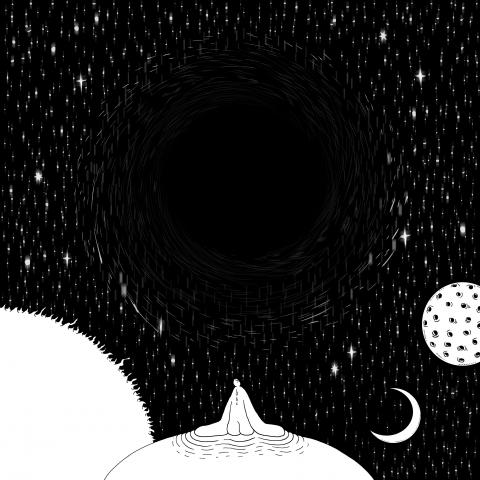A few years ago, during a period of insomnia, I briefly got into the habit of contributing to the online project Galaxy Zoo. I would log on to a Web site that presented, one after another, singular images of tens of thousands of galaxies observed by the Hubble telescope, each billions of light years away. There were so many of these images that cosmologists had opened them up to thousands of amateur volunteers to help narrow down the field of those galaxies that warranted closer study.
Peering at my dimmed computer screen in the early hours at catherine wheels of stars that perhaps no human eye had ever seen, I ticked the relevant boxes that would assist in classifying them — “elliptical or spiral?”; “smooth or fuzzy?” — and then paused for a while over the open-ended final question: “Is there anything odd in this image?” — an inquiry that always seemed to beg the reply: “You mean, beyond the fact that it is a rotating mass of incalculable solar systems that likely expired untold millions of years ago?”
I stopped logging on after a few nights. What I had thought might be a productive way of counting sheep turned out to be both unsettling and unhelpful. Despite my better instincts, I could not sustain the patience the task required — the galaxies started to look dully familiar; I needed more surprise. And then I fretted that in disrespectful haste I might have overlooked some critical element of a formation and condemned it for ever to scientific obscurity.

Illustration: Mountain People
I eventually gave up after I lay wide awake one night, having closed my laptop, wondering why on earth I had imagined that contemplating all the universe’s cold and ancient vastness in thumbnail images might be conducive to decent shut-eye.
I was reminded of all that last week when the extraordinary first image of a black hole was revealed at a news conference of the US National Science Foundation in Washington. The image, the result of a decade-long international project coordinating eight far-flung telescopes, including one at the South Pole, trailed all kinds of spectacular statistics. The black hole was in a galaxy, Messier 87, that was 55 million light years away. It had an estimated mass equivalent to that of 6.5 billion of our suns, condensed into a tiny speck. Creating the image was the equivalent of focusing on a teacup on the moon.
However, immediately after this epochal vision had formed before our collective eyes, we obviously set about the urgent task of reducing all of its unfathomable implications to down-to-earth concepts. The me-first meme engine of Twitter soon got to work on it. It was Homer Simpson’s doughnut; it was my adorable cat’s evil eye; it was a spaghetti hoop on a universe of toast; it was the promise of quick release from Brexit woes. And almost as quickly, the black hole was seized upon in other corners of the Internet by sermonizers of any faith and none; it was evidence of God’s wrath, or his purpose, or his absence.
By the time the following morning’s papers had landed, the hole was being framed to fit the usual formulas. The primary concern of the tabloid press appeared to be the question of whether the black hole was an imminent threat to us or our house prices. Readers in the UK of that favorite cosmologists’ title, the Sun, were therefore asked the question of “whether you would survive falling into” a four-dimensional structure in which space and time lose their individuality and merge, as if it were an unguarded manhole.
The general consensus was that you would not — not least because the difference in gravity between your head and your feet “would stretch you out like a piece of chewing gum.”
Meanwhile, the liberal media and their detractors had decided that the crucial thing about visual proof of a place of infinite density trapping light was an Internet troll war about the gender of the prime mover in its discovery. The subject of that discussion, the inspirational 29-year-old American computer scientist Katie Bouman, who helped to create the algorithm that enabled the image, was at pains to argue that, honestly, the story was not really about her.
But what did she know?
By now, the black hole had been subsumed into that equally efficient obliterator of reality, the 24-hour news cycle.
Before it completely disappeared over its own event horizon, some facts that proved the scale of the achievement seemed worth clinging on to. One was the fact that even Albert Einstein, whose field equations first predicted the possibility of a “singularity” that could collapse forever, could not bring himself quite to acknowledge the evidence of his own mathematics. The proof was extrapolated from his 1915 paper on general relativity by his contemporary Karl Schwarzschild. Although Einstein accepted the theoretical basis of that proof, even in 1939 he was producing a paper that offered, he said, “a clear understanding as to why Schwarzschild singularities do not exist in physical reality.”
It says something about our historical moment — or about the intrinsic limits of our capacity for wonder — that the image of this physical reality is so effortlessly normalized. We probably do less stargazing, as a species, than at any previous moment in human history, but the old reflex to anthropomorphize the universe, to insist on ourselves in the center of it, persists.
As T.S. Eliot observed in his meditation on Einstein’s space-time continuum in Burnt Norton, “humankind cannot bear too much reality.”
The science proves the black hole is way beyond most of our understanding, but the evidence now in front of our eyes reminds us that the simplest principle of the universe remains the hardest for us to grasp: It is not about us.

In the past month, two important developments are poised to equip Taiwan with expanded capabilities to play foreign policy offense in an age where Taiwan’s diplomatic space is seriously constricted by a hegemonic Beijing. Taiwan Foreign Minister Lin Chia-lung (林佳龍) led a delegation of Taiwan and US companies to the Philippines to promote trilateral economic cooperation between the three countries. Additionally, in the past two weeks, Taiwan has placed chip export controls on South Africa in an escalating standoff over the placing of its diplomatic mission in Pretoria, causing the South Africans to pause and ask for consultations to resolve
An altercation involving a 73-year-old woman and a younger person broke out on a Taipei MRT train last week, with videos of the incident going viral online, sparking wide discussions about the controversial priority seats and social norms. In the video, the elderly woman, surnamed Tseng (曾), approached a passenger in a priority seat and demanded that she get up, and after she refused, she swung her bag, hitting her on the knees and calves several times. In return, the commuter asked a nearby passenger to hold her bag, stood up and kicked Tseng, causing her to fall backward and
In South Korea, the medical cosmetic industry is fiercely competitive and prices are low, attracting beauty enthusiasts from Taiwan. However, basic medical risks are often overlooked. While sharing a meal with friends recently, I heard one mention that his daughter would be going to South Korea for a cosmetic skincare procedure. I felt a twinge of unease at the time, but seeing as it was just a casual conversation among friends, I simply reminded him to prioritize safety. I never thought that, not long after, I would actually encounter a patient in my clinic with a similar situation. She had
The election campaign for the Chinese Nationalist Party (KMT) chair is heating up, with only 10 days left before party members cast their ballots on Oct. 18. The campaign has revealed potential strengths for the party going into important elections next year and in 2028, particularly the desire among leading candidates to deepen cooperation with the Taiwan People’s Party (TPP). However, it has also exposed the party’s persistent weaknesses, especially in formulating a policy on cross-strait relations that can appeal to the majority of Taiwanese. Six candidates are registered: former Taipei mayor Hau Lung-bin (郝龍斌), 73; former legislator Cheng Li-wun